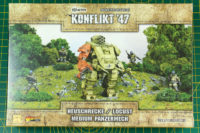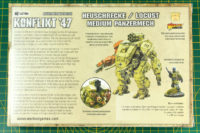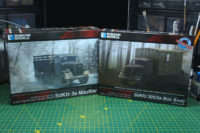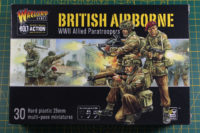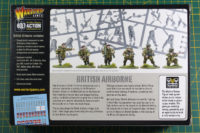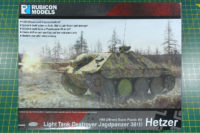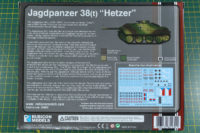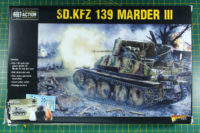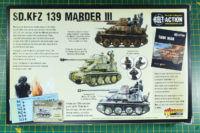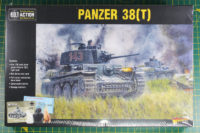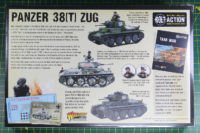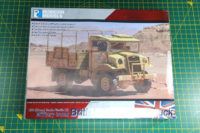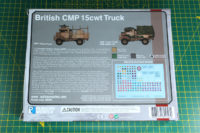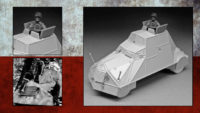Konflikt 47 Locust Medium Panzermech
Picking up the theme of Konflikt 47 once again. We cover today an interesting counter-part to the jump walkers of the Allied Forces, like the M2 Mudskipper, the Locust Panzermech by the Axis.
Konflikt '47 is a joint project by Warlord Games and Clockwork Goblin and is set upon an updated Bolt Action's First Edition ruleset. Some of the kits make use of the existing range of Bolt Action, add additional parts to them (like the tanks) or are complete newly designed kits, like these walkers.
Bolt Action Opel Blitz & Maultier
In late 2017 Warlord Games covered the Opel Blitz / Maultier combi plastic kit for Bolt Action.
The truck is one of the workhorses of the German army, transporting troops, supplies and ammunition were they were needed. The Opel Blitz is the most known of these trucks, other companies like Ford or Daimler supplied their own trucks, in some cases like the DB 701 by Daimler, it was simply the Opel Blitz without the markings built under license.
Where the Opel Blitz was build between 1937 and 1944 and made it to around 70,000 units, the half track variant of the Opel Maultier was released later in 1942/43 and around 20,000 units were built. As these trucks were the standard solution for logistics of all kind, there were multiple variants of them, converted and built for use as ambulance, communication, weapon carriage and even uparmoured ones.
Rubicon Models SdKfz 301a Opel Maultier with Box Body
Based upon the already available Opel Blitz Kit (RM280026), Rubicon published the Maultier variant that replaces the rear wheels with tracks. As with some of their other kits, like the SdKfz 25x, they cover further accessories. For the Blitz and Maultier there is the option to upgrade the cargo bed with the box body "Einheitskoffer".
After the first winter in 1941 on the Eastern Front, the German army high command realised that the trucks weren't capable of handling the weather and terrain conditions. The vehicles often got stuck in the mud and snow. A unit of the Waffen-SS build the tracks of a Bren Carrier under a truck to confront those conditions. After realising the benefits of this modification in 1942, Opel, Ford and Daimler added these variants to their truck production. Depending on by whom the LKW Gleiskette 2t was build, it was called SdKfz 3a (in case it was built by Opel), 3b (Ford V3000 S) or 3c (Daimler L4500). The variant was called Maultier (mule) and further variants were build upon the halftrack vehicles, like the Panzerwerfer or with a 2-cm Flak 38.
Das Boot – inspiring wargaming
I watched the tv mini-series version of the original movie Das Boot from 1981 on amazon prime last year or the year before. It had enhanced audio and video quality, with 6 episodes covering 52 minutes each. In November and December 2018 a tv series sequel of the same name, was released as an 8-part. It plays 9 month after the original movie, and due to the nearly 40 years between both movies, of course with different actors. I had the chance to see the location and mock-up of the submarine in Munich, in the Bavaria Filmstudio. It was quite impressive to see and transported the claustrophobic atmosphere of the submarine quite well.
Bolt Action British Airborne
One of the latest kits and the youngest of the paratrooper plastic kits, are the British Airborne. A must for this week's series of reviews around the Operation Market Garden along with yesterday's US Airborne kit.
The British airborne is one of the many special combat divisions of the commonwealth's armed forces. They were founded in 1941, roughly a year earlier than their US American counterpart, and the 1st Airborne Division was send to North Africa for Operation Torch. But this kit covers the Red Devils in their North Western European gear, making them the best fit for the mid to late war operations of Pegasus Bridge, Operation Market Garden and the late fights crossing the Rhine / Operation Varsity, the largest airborne operation in history. In cinema the British paratroopers are mostly known from A bridge too far.
Rubicon Models Jagdpanzer 38(t) Hetzer
You can't talk about the 38(t) series without mentioning the Jagdpanzer 38(t) Hetzer, and that is why today I cover the kit by Rubicon Models in this review.
As the tank destroyers Marder based upon the Panzer 38(t) were more of an industrialized "field conversion" using captured anti-tank guns and later regular PaKs, a properly designed light tank destroyer was needed. Introduced as the Sd.Kfz. 138/2 Jagdpanzer 38(t), this tank was produced from April 1944 until the end of the war, along the heavier Jagdpanther and Jagdtiger variants. The name "Hetzer" is undocumented and it is unclear, were it actually came from and it is highly discussed if the tank even was called that during the war. Hetzer comes from the German verb "hetzen", meaning hounding or rushing somebody or something.
Bolt Action Sd.Kfz. 139 Marder III
Continuing the Panzer 38(t) themed review week, with the Marder III Ausf. H tank destroyer based on the Panzer 38(t) chassis.
Based upon the chassis of the Sd.Kfz. 140 Panzer 38(t), a tank destroyer called Marder III was brought into service. The whole Marder series were makeshift tank destroyers, an interim solution, to put captured or obsolete vehicles in to use, by arming them at first with captured field guns and later with German PaK anti-tank guns. The Marder I was built upon the French Lorraine tank and the Marder II on the surplus of rapidly becoming obsolete Panzer II tanks. Marder is German for marten. The Marder III was built in three variants, as Sd.Kfz. 139, Sd.Kfz. 138 Ausf. H and Ausf. M.
Bolt Action Panzer 38(t)
Let us begin this themed week of reviews around the Panzer 38(t) with the tank itself, in this case the new plastic kit by Warlord Games.
The Panzer 38(t), registered as Sd.Kfz. 140 in Germany, was originally a pre-world war II pattern from Czechoslovakia named LT vz. 38 (Lehký tank vzor 38, Light Tank model 38). After the Third Reich took over Czechoslovakia, the tank was adopted into german service and formed the basis for many variants. Many of those variants will be covered here on the blog in the next days.
Rubicon Models British CMP 15cwt Truck
In addition to the Northern Africa campaign week in November, I want to cover the British CMP 15cwt Truck by Rubicon Models in a review today.
The CMP stands for canadian military pattern. This truck was build in Canada and used by armies of the British Commonwealth and even sent to the Soviet Union after Operation Barbarossa. Due to this, it saw action on theatres of war all over the world, from the North African Campaign, Italy, Burma and even after the second World War in Indonesia, Indochina and portuguese colonies in Africa. In Australian service (almost always with the No. 13 cab as supplied with this kit), the CMP was known as "Chev Blitz" or "Ford Blitz".
Infamous JT Warsaw Uprising Kubus
The "crown jewel" of the currently running Warsaw Uprising Kickstarter campaign by Infamous JT is most certainly the Kubus, that I want to show you in this pre-release review.
The Warsaw Uprising is part of the late war years of the second world war. It was an operation of the polish Home Army (Armia Krajowa) to liberate Warsaw from the German occupation. There were resistance cells in many occupied countries, in some cases the Allies supported the resistance with equipment and gear, in other cases the underground look after themselfes. In this case, the polish resistance built an armoured car in secret, based on a Chevrolet 157 truck and called it "Little Jakob" (Kubuś). It was one of a kind and often seen with a captured Sd.Kfz.251/3 Ausf.D named Grey Wolf.
